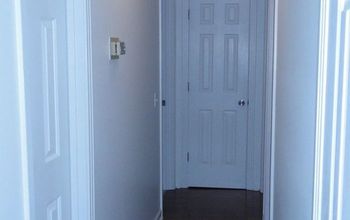Handicap Ramp

-
For every 1 inch rise, 1 foot of length. http://www.mobility-advisor.com/wheelchair-ramp-specs.html
 Donna Byram
on May 13, 2014
Helpful Reply
Donna Byram
on May 13, 2014
Helpful Reply -
-
According to ADA requirements Ideally for every 12 inches in length you need to rise no more than three inches in height. So for a deck that is 4 foot high the ramp, assuming no platforms needs to be 16 foot long. Simply divide the height in total inches by 3 and that will give you your length. If you can I would suggest that if you have room change the pitch to 1.5 inches per foot. It will make the ramp 32 foot long but much easier to use. Ideally a platform about half way up is a good idea. Length is figured on ramp location only, do not include any platforms switchbacks or porch. Other information that you may need is the width of the ramp itself should be no narrower than 36 inches from inside handrail to inside handrail. Ideally four foot wide is ideal. A lip along the side of the ramp should be at least 2 inches high with railing above. The platform at the top by the door needs to be a minimum of 5 foot square with an added 12 inches per door foot width should it open to the outside. This is to enable the door to open while the chair remains on the porch platform. Switch back platforms where you need to turn the ramp back towards the house need to be at least 8 foot long by four foot wide to enable turns and a place to rest if the length of the ramp is really long. There should also be a landing area at the bottom of the ramp at least 5 foot square. Remember also if the person that requires the ramp and if they live alone, there should be at least two ramps available from two exits of the house should a fire break out.
 Woodbridge Environmental Tiptophouse.com
on May 13, 2014
Helpful Reply
Woodbridge Environmental Tiptophouse.com
on May 13, 2014
Helpful Reply -
-
We are not at the age where we need a ramp, but I clipped this just in case. When we built out a playroom into a downstairs master years ago, we left a window accessible to making a door if needed later. If we ever need to, we can build a screen porch on the side of the house and put a ramp out to the sidewalk. It might cost a few $$, but it is cheaper than moving! Thank all of you for this information!
 Jeanette S
on May 14, 2014
Helpful Reply
Jeanette S
on May 14, 2014
Helpful Reply -
-
For really long term living one should look into a elevator for the house. Many years ago I was involved in converting some homes in where we installed the elevator on the side of the house and used the windows on each level for the door entrance into the home. A slab was poured on the outside with footings and three walls were constructed much like you would see for a add on fireplace. We cut out the window openings for each floor installed a sidewalk to the driveway and you would never know this feature was there. Many newer homes are designed with a future elevator in mind. Larger coat closets located above each other is common now in new homes. You will also find that more and more homes have door handles that are lever types. The round knob is a thing of the past. Its much easier to push a handle then turn a knob as we loose our dexterity in our hands. Another tip is a package shelf next to the front door. How often do we fumble with our packages while we look for our front door keys? Aging adults have it harder as they attempt to bend over just to set them down. A simple shelf next to the door allows for them to set things down without having to bend over.
 Woodbridge Environmental Tiptophouse.com
on May 14, 2014
Helpful Reply
Woodbridge Environmental Tiptophouse.com
on May 14, 2014
Helpful Reply -
-
Thanks, but that's not an option. They don't have that kind of $. It's a 1 story home. The porch will be 4' off the ground, so an elevator is a bit much. I still need an answer on the angle, pitch, and length of the ramp needed for this project.
 Kirt N
on May 14, 2014
Helpful Reply
Kirt N
on May 14, 2014
Helpful Reply -
-
Kirt its already posted. Max angle is 3 inches per foot run. Ideally 1.5 inches per foot run. With a porch that is 4 foot high, divided by 48" the length of the run can be as short as 16 foot or ideally 32 foot long. If cash is issue, there should be insurance money that will cover part of the cost available. Or simply check with local living assistance companies in your area. They can provide metal temp style and invoice your medical policy as required. There is money available you just need to search it out.
 Woodbridge Environmental Tiptophouse.com
on May 14, 2014
Helpful Reply
Woodbridge Environmental Tiptophouse.com
on May 14, 2014
Helpful Reply -
-
My daughter is in a wheelchair, we have a ramp installed at our front door and a folding ramp that's portable. We've always been told that you need 1 foot of length for every inch of height
 Polly Zieper
on May 14, 2014
Helpful Reply
Polly Zieper
on May 14, 2014
Helpful Reply -
-
that is correct
 Suzanne
on May 15, 2014
Helpful Reply
Suzanne
on May 15, 2014
Helpful Reply -
Related Discussions
Vinyl plank flooring vs pergo (laminate)
I currently have stinky dirty carpeting in my living room and I want to replace it with a durable flooring that can stand up to dogs and kids.
How to remove popcorn ceiling that has been painted?
Does having a paint over a popcorn ceiling change how I'd remove the popcorn ceiling?
How to apply peel and stick wallpaper?
I want to spruce up my walls with peel-and-stick wallpaper. Has anyone used this before and can advise me as to how to apply it properly?
How to stain wood floor?
I've heard staining is a good technique for updating floors. So how do I stain my wood floor?
Porch Railing or Porch Wall? What Do You Think?
We've in the process of building a porch onto the front and side of our house (wraparound). We have the porch floor on, and now we're stuck, trying to decide which wo... See more
Can outdoor carpet (the green stuff) be applied to an exposed deck?
We have a deck that we spent three weekends re-doing with a HGTV recommended deck restoration product that peeled in 9 months. Cleaned and scraped, replaced rotted bo... See more


